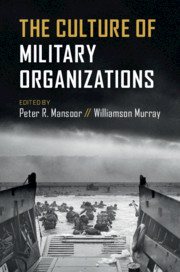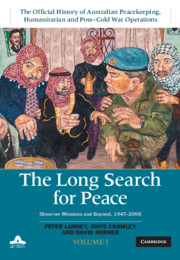Refine search
Actions for selected content:
15418 results in Military history
19 - An island divided
- from Part 2 - New ambitions
-
- Book:
- The Long Search for Peace
- Published online:
- 27 September 2019
- Print publication:
- 09 October 2019, pp 482-504
-
- Chapter
- Export citation
Part 1 - Actor and observer
-
- Book:
- The Long Search for Peace
- Published online:
- 27 September 2019
- Print publication:
- 09 October 2019, pp 1-392
-
- Chapter
- Export citation
23 - Fumbling the political football
- from Part 2 - New ambitions
-
- Book:
- The Long Search for Peace
- Published online:
- 27 September 2019
- Print publication:
- 09 October 2019, pp 578-604
-
- Chapter
- Export citation
11 - ‘If you’re not confused, you don’t understand the situation’
- from Part 1 - Actor and observer
-
- Book:
- The Long Search for Peace
- Published online:
- 27 September 2019
- Print publication:
- 09 October 2019, pp 277-294
-
- Chapter
- Export citation
25 - Into Africa
- from Part 2 - New ambitions
-
- Book:
- The Long Search for Peace
- Published online:
- 27 September 2019
- Print publication:
- 09 October 2019, pp 622-639
-
- Chapter
- Export citation

The Culture of Military Organizations
-
- Published online:
- 05 October 2019
- Print publication:
- 17 October 2019

The Long Search for Peace
- Observer Missions and Beyond, 1947–2006
-
- Published online:
- 27 September 2019
- Print publication:
- 09 October 2019

The Karl Muck Scandal
- Classical Music and Xenophobia in World War I America
-
- Published by:
- Boydell & Brewer
- Published online:
- 06 September 2019
- Print publication:
- 01 June 2019
5 - Strategy: How to Think about Fighting for a Limited Political Objective
-
- Book:
- Why America Loses Wars
- Published online:
- 09 August 2019
- Print publication:
- 29 August 2019, pp 121-171
-
- Chapter
- Export citation
Introduction
-
- Book:
- Type 42 Destroyer Southampton
- Published by:
- Amsterdam University Press
- Published online:
- 27 March 2024
- Print publication:
- 29 August 2019, pp 2-56
-
- Chapter
- Export citation
Contents
-
- Book:
- Why America Loses Wars
- Published online:
- 09 August 2019
- Print publication:
- 29 August 2019, pp vii-viii
-
- Chapter
- Export citation
2 - The Way We Think about War (Particularly Limited War) Is Broken: Here Is How We Fix It
-
- Book:
- Why America Loses Wars
- Published online:
- 09 August 2019
- Print publication:
- 29 August 2019, pp 20-43
-
- Chapter
- Export citation
Acknowledgments
-
- Book:
- Why America Loses Wars
- Published online:
- 09 August 2019
- Print publication:
- 29 August 2019, pp 232-233
-
- Chapter
- Export citation
Frontmatter
-
- Book:
- Type 42 Destroyer Southampton
- Published by:
- Amsterdam University Press
- Published online:
- 27 March 2024
- Print publication:
- 29 August 2019, pp 1-1
-
- Chapter
- Export citation
Dedication
-
- Book:
- Why America Loses Wars
- Published online:
- 09 August 2019
- Print publication:
- 29 August 2019, pp v-vi
-
- Chapter
- Export citation
3 - The Political Objective: Why Nations Fight (Limited) Wars
-
- Book:
- Why America Loses Wars
- Published online:
- 09 August 2019
- Print publication:
- 29 August 2019, pp 44-80
-
- Chapter
- Export citation
Copyright page
-
- Book:
- Why America Loses Wars
- Published online:
- 09 August 2019
- Print publication:
- 29 August 2019, pp iv-iv
-
- Chapter
- Export citation
Bibliography
-
- Book:
- Why America Loses Wars
- Published online:
- 09 August 2019
- Print publication:
- 29 August 2019, pp 269-318
-
- Chapter
- Export citation
Conclusion: Is History Rhyming?
-
- Book:
- Why America Loses Wars
- Published online:
- 09 August 2019
- Print publication:
- 29 August 2019, pp 221-231
-
- Chapter
- Export citation
Index
-
- Book:
- Why America Loses Wars
- Published online:
- 09 August 2019
- Print publication:
- 29 August 2019, pp 319-332
-
- Chapter
- Export citation
